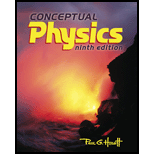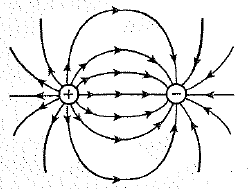
CONCEPTUAL PHYSICS-W/PRACTICING PHYSICS
9th Edition
ISBN: 9780321052025
Author: Hewitt
Publisher: PEARSON
expand_more
expand_more
format_list_bulleted
Textbook Question
Chapter 33, Problem 6A
How is the strength of an electric field indicated with field lines?

Expert Solution & Answer
To determine
To explain: The strength of an electric field indicated with field lines
Explanation of Solution
The strength of electric field at a point can be depicted by the number of lines passing at a point. Lots of closely space lines show strong electric field, whereas a few widely spaced lines mean a weak electric field.
Chapter 33 Solutions
CONCEPTUAL PHYSICS-W/PRACTICING PHYSICS
Ch. 33 - What is meant by the expression action at a...Ch. 33 - How does the concept of a field eliminate the idea...Ch. 33 - How are a gravitational field and an electric...Ch. 33 - Why is an electric field considered a vector...Ch. 33 - a. What are electric field lines? b. How do their...Ch. 33 - How is the strength of an electric field indicated...Ch. 33 - Describe the electric field lines in the space...Ch. 33 - Why are occupants safe inside a car struck by...Ch. 33 - a. Can gravity be shielded? b. Can electric fields...Ch. 33 - What happens to the electric field inside a...
Ch. 33 - What is the relationship between the amount of...Ch. 33 - What will happen to the electrical potential...Ch. 33 - Clearly distinguish between electrical potential...Ch. 33 - If you do more work to move more charge a certain...Ch. 33 - The SI unit for electrical potential energy is the...Ch. 33 - Charge must be present at a location in order for...Ch. 33 - How can electric potential be high when electrical...Ch. 33 - How does the amount of charge on the plate of a...Ch. 33 - How does the amount of charge on the inside...Ch. 33 - How much voltage can be built up on a Van de...Ch. 33 - The diagrams A, B, and C represent pairs of...Ch. 33 - Rank from greatest to least the force on the...Ch. 33 - Three charged particles are in an electric field...Ch. 33 - A charged ball is suspended by a string in a...Ch. 33 - Shown below are three hollow copper spheres....Ch. 33 - How is an electric field different from a...Ch. 33 - The vectors for the gravitational field of Earth...Ch. 33 - Imagine an electron and a proton held midway...Ch. 33 - Suppose that the strength of the electric field...Ch. 33 - When a conductor is charged, the charge moves to...Ch. 33 - Suppose that a metal tile cabinet is charged. How...Ch. 33 - Does an object with twice the electric potential...Ch. 33 - You are not harmed by contact with a charged...Ch. 33 - Why does your hair stand out when you are charged...Ch. 33 - If you put in 10 joules of work to push 1 coulomb...Ch. 33 - At a particular point near a second charge, a 50-C...Ch. 33 - When placed near another charge, a 20-C charge...Ch. 33 - A 12-C charge is located in a 350-N/C electric...Ch. 33 - a. If you do 12 J of work to push 0.001 C of...Ch. 33 - What is the voltage at the location of a 0.0001-C...Ch. 33 - a. Suppose that you start with a charge of 0.002 C...Ch. 33 - Point A is at +10V, point B is at +7V, and point C...Ch. 33 - In a hydrogen atom, the proton and the electron...Ch. 33 - The potential difference between a storm cloud and...
Additional Science Textbook Solutions
Find more solutions based on key concepts
Why is it necessary to be in a pressurized cabin when flying at 30,000 feet?
Anatomy & Physiology (6th Edition)
Plants use the process of photosynthesis to convert the energy in sunlight to chemical energy in the form of su...
Campbell Essential Biology with Physiology (5th Edition)
All of the following processes are involved in the carbon cycle except: a. photosynthesis b. cell respiration c...
Human Biology: Concepts and Current Issues (8th Edition)
How does an obligate aerobe differ from a facultative aerobe?
Brock Biology of Microorganisms (15th Edition)
3. What are serous membranes, and what are their functions?
Human Anatomy & Physiology (2nd Edition)
4. Three groups of nonvascular plants are _______, ______, and _______. Three groups of seedless vascular plant...
Biology: Life on Earth (11th Edition)
Knowledge Booster
Learn more about
Need a deep-dive on the concept behind this application? Look no further. Learn more about this topic, physics and related others by exploring similar questions and additional content below.Similar questions
- What are the expected readings of the ammeter and voltmeter for the circuit in the figure below? (R = 5.60 Ω, ΔV = 6.30 V) ammeter I =arrow_forwardsimple diagram to illustrate the setup for each law- coulombs law and biot savart lawarrow_forwardA circular coil with 100 turns and a radius of 0.05 m is placed in a magnetic field that changes at auniform rate from 0.2 T to 0.8 T in 0.1 seconds. The plane of the coil is perpendicular to the field.• Calculate the induced electric field in the coil.• Calculate the current density in the coil given its conductivity σ.arrow_forward
- An L-C circuit has an inductance of 0.410 H and a capacitance of 0.250 nF . During the current oscillations, the maximum current in the inductor is 1.80 A . What is the maximum energy Emax stored in the capacitor at any time during the current oscillations? How many times per second does the capacitor contain the amount of energy found in part A? Please show all steps.arrow_forwardA long, straight wire carries a current of 10 A along what we’ll define to the be x-axis. A square loopin the x-y plane with side length 0.1 m is placed near the wire such that its closest side is parallel tothe wire and 0.05 m away.• Calculate the magnetic flux through the loop using Ampere’s law.arrow_forwardDescribe the motion of a charged particle entering a uniform magnetic field at an angle to the fieldlines. Include a diagram showing the velocity vector, magnetic field lines, and the path of the particle.arrow_forward
- Discuss the differences between the Biot-Savart law and Coulomb’s law in terms of their applicationsand the physical quantities they describe.arrow_forwardExplain why Ampere’s law can be used to find the magnetic field inside a solenoid but not outside.arrow_forward3. An Atwood machine consists of two masses, mA and m B, which are connected by an inelastic cord of negligible mass that passes over a pulley. If the pulley has radius RO and moment of inertia I about its axle, determine the acceleration of the masses mA and m B, and compare to the situation where the moment of inertia of the pulley is ignored. Ignore friction at the axle O. Use angular momentum and torque in this solutionarrow_forward
- A 0.850-m-long metal bar is pulled to the right at a steady 5.0 m/s perpendicular to a uniform, 0.650-T magnetic field. The bar rides on parallel metal rails connected through a 25-Ω, resistor (Figure 1), so the apparatus makes a complete circuit. Ignore the resistance of the bar and the rails. Please explain how to find the direction of the induced current.arrow_forwardFor each of the actions depicted, determine the direction (right, left, or zero) of the current induced to flow through the resistor in the circuit containing the secondary coil. The coils are wrapped around a plastic core. Immediately after the switch is closed, as shown in the figure, (Figure 1) in which direction does the current flow through the resistor? If the switch is then opened, as shown in the figure, in which direction does the current flow through the resistor? I have the answers to the question, but would like to understand the logic behind the answers. Please show steps.arrow_forwardWhen violet light of wavelength 415 nm falls on a single slit, it creates a central diffraction peak that is 8.60 cm wide on a screen that is 2.80 m away. Part A How wide is the slit? ΟΙ ΑΣΦ ? D= 2.7.10-8 Submit Previous Answers Request Answer × Incorrect; Try Again; 8 attempts remaining marrow_forward
arrow_back_ios
SEE MORE QUESTIONS
arrow_forward_ios
Recommended textbooks for you
 College PhysicsPhysicsISBN:9781305952300Author:Raymond A. Serway, Chris VuillePublisher:Cengage Learning
College PhysicsPhysicsISBN:9781305952300Author:Raymond A. Serway, Chris VuillePublisher:Cengage Learning University Physics (14th Edition)PhysicsISBN:9780133969290Author:Hugh D. Young, Roger A. FreedmanPublisher:PEARSON
University Physics (14th Edition)PhysicsISBN:9780133969290Author:Hugh D. Young, Roger A. FreedmanPublisher:PEARSON Introduction To Quantum MechanicsPhysicsISBN:9781107189638Author:Griffiths, David J., Schroeter, Darrell F.Publisher:Cambridge University Press
Introduction To Quantum MechanicsPhysicsISBN:9781107189638Author:Griffiths, David J., Schroeter, Darrell F.Publisher:Cambridge University Press Physics for Scientists and EngineersPhysicsISBN:9781337553278Author:Raymond A. Serway, John W. JewettPublisher:Cengage Learning
Physics for Scientists and EngineersPhysicsISBN:9781337553278Author:Raymond A. Serway, John W. JewettPublisher:Cengage Learning Lecture- Tutorials for Introductory AstronomyPhysicsISBN:9780321820464Author:Edward E. Prather, Tim P. Slater, Jeff P. Adams, Gina BrissendenPublisher:Addison-Wesley
Lecture- Tutorials for Introductory AstronomyPhysicsISBN:9780321820464Author:Edward E. Prather, Tim P. Slater, Jeff P. Adams, Gina BrissendenPublisher:Addison-Wesley College Physics: A Strategic Approach (4th Editio...PhysicsISBN:9780134609034Author:Randall D. Knight (Professor Emeritus), Brian Jones, Stuart FieldPublisher:PEARSON
College Physics: A Strategic Approach (4th Editio...PhysicsISBN:9780134609034Author:Randall D. Knight (Professor Emeritus), Brian Jones, Stuart FieldPublisher:PEARSON

College Physics
Physics
ISBN:9781305952300
Author:Raymond A. Serway, Chris Vuille
Publisher:Cengage Learning

University Physics (14th Edition)
Physics
ISBN:9780133969290
Author:Hugh D. Young, Roger A. Freedman
Publisher:PEARSON

Introduction To Quantum Mechanics
Physics
ISBN:9781107189638
Author:Griffiths, David J., Schroeter, Darrell F.
Publisher:Cambridge University Press

Physics for Scientists and Engineers
Physics
ISBN:9781337553278
Author:Raymond A. Serway, John W. Jewett
Publisher:Cengage Learning

Lecture- Tutorials for Introductory Astronomy
Physics
ISBN:9780321820464
Author:Edward E. Prather, Tim P. Slater, Jeff P. Adams, Gina Brissenden
Publisher:Addison-Wesley

College Physics: A Strategic Approach (4th Editio...
Physics
ISBN:9780134609034
Author:Randall D. Knight (Professor Emeritus), Brian Jones, Stuart Field
Publisher:PEARSON
Series & Parallel - Potential Divider Circuits - GCSE & A-level Physics; Author: Science Shorts;https://www.youtube.com/watch?v=vf8HVTVvsdw;License: Standard YouTube License, CC-BY